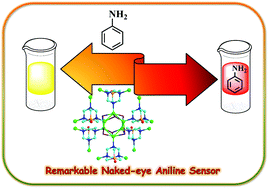A novel 2D coordination network built from hexacopper(i)-iodide clusters and cagelike aminophosphine blocks for reversible “turn-on” sensing of aniline†
Abstract
A new copper(I) coordination polymer [Cu6(μ3-I)6(μ3-PTA![[double bond, length as m-dash]](https://www.rsc.org/images/entities/char_e001.gif) O)2]n (1) was prepared from copper(I) iodide and 1,3,5-triaza-7-phosphaadamantane-7-oxide (PTA
O)2]n (1) was prepared from copper(I) iodide and 1,3,5-triaza-7-phosphaadamantane-7-oxide (PTA![[double bond, length as m-dash]](https://www.rsc.org/images/entities/char_e001.gif) O). The crystal structure of 1 reveals an intricate 2D coordination network constructed from the hexacopper(I)-iodide [Cu6(μ3-I)6] cluster units with the 4M6-1 topology interlinked by the μ3-PTA
O). The crystal structure of 1 reveals an intricate 2D coordination network constructed from the hexacopper(I)-iodide [Cu6(μ3-I)6] cluster units with the 4M6-1 topology interlinked by the μ3-PTA![[double bond, length as m-dash]](https://www.rsc.org/images/entities/char_e001.gif) O spacers. An overall 2D layer network can be simplified to a binodal 3,6-connected net with the kgd topology. A derived 1@paper material was prepared by impregnating compound 1 onto a filter paper. Detailed investigation of the luminescence properties for 1 and 1@paper in the solid state revealed a remarkable ability of both materials to sense aniline molecules in liquid and vapor phases at room temperature. The visibility to the naked eye and the reversible color response of 1 and 1@paper upon contact with aniline make these materials rather promising candidates for application as “turn-on” luminescence sensors for aniline recognition at room temperature. Visual aniline sensing detection limits of 0.26 and 0.065 ppb were observed for 1 and 1@paper under ambient conditions, respectively.
O spacers. An overall 2D layer network can be simplified to a binodal 3,6-connected net with the kgd topology. A derived 1@paper material was prepared by impregnating compound 1 onto a filter paper. Detailed investigation of the luminescence properties for 1 and 1@paper in the solid state revealed a remarkable ability of both materials to sense aniline molecules in liquid and vapor phases at room temperature. The visibility to the naked eye and the reversible color response of 1 and 1@paper upon contact with aniline make these materials rather promising candidates for application as “turn-on” luminescence sensors for aniline recognition at room temperature. Visual aniline sensing detection limits of 0.26 and 0.065 ppb were observed for 1 and 1@paper under ambient conditions, respectively.



 Please wait while we load your content...
Please wait while we load your content...